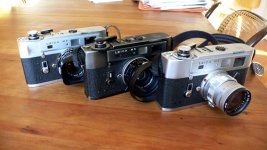kevin m
Veteran
Wayne, I'm going to be joining you as an M5 owner as well as a VI-T owner. 😀 I finally caved into temptation and bought the M5 Leif was selling here. Should be arriving early in the New Year.
I've owned several M bodies before, but I haven't so much as seen an M5, never mind held one, so it's a bit of a gamble. I was going to go with either a Bessa R3A, or an M2/3, but neither option was entirely attractive. Part of the appeal of rangefinders, for me, is the build quality of the old cameras, and the M5 seems to have that, plus it has the convenience of the meter, so I'm hoping it's the best of both worlds: The old-world build quality of the classic Leicas with the convenience of a meter.
I'll post a pic with the Canon 50/1.2 mounted as soon as it arrives. 🙂
I've owned several M bodies before, but I haven't so much as seen an M5, never mind held one, so it's a bit of a gamble. I was going to go with either a Bessa R3A, or an M2/3, but neither option was entirely attractive. Part of the appeal of rangefinders, for me, is the build quality of the old cameras, and the M5 seems to have that, plus it has the convenience of the meter, so I'm hoping it's the best of both worlds: The old-world build quality of the classic Leicas with the convenience of a meter.
I'll post a pic with the Canon 50/1.2 mounted as soon as it arrives. 🙂


